Abstract
We live amidst a flood of information in the internet and digital revolution era. Due to such indiscriminate information access, there are many problems in accurately recognizing the information desired by the user. Moreover, there are many difficulties with finding accurate information and the articles that individuals want due to indiscriminate advertisements in various online papers such as SNS and internet newspapers. Negative experiences with these advertisements lead to advertisement avoidance; if media users avoid advertisements, the media’s existence is threatened. This system aims to provide high-quality online articles, excluding promotions, by designing a system using a knowledge-based management system (KBMS) and Deep Learning system to solve the problems of advertisement. In other words, this system compares advertisement phrases or general keywords related to a specific company and product promotion with the contents to be searched in the database system of the knowledge-based management service.
1. Introduction and Research Background
We live amidst a flood of information in the internet and digital revolution era. Due to such indiscriminate information access, there are many problems in accurately recognizing the information desired by the user. Moreover, there are many difficulties with finding accurate information and the articles that individuals want due to indiscriminate advertisements in various online papers such as SNS and internet newspapers.
In the 21st century, media organizations such as newspapers and public broadcasters overseeing the distribution of knowledge and information have become somewhat difficult to operate. The reason is that, as cutting-edge personal information-sharing devices such as the internet, Twitter, and SNS have become popular recently, media organizations can quickly and accurately inform the public of various information that the public has not been able to grasp, and a monopoly structure generates profits by performing advertisements for multiple companies [1].
This was limited to offline advertisements in newspapers and magazines in the past. Still, these days as the internet and communication are developed, many parts of the advertisement market change due to the expansion of article advertisements, such as banner advertisements, and the provision of various types of information online. I think this change is the biggest reason.
In recent years, there has been an increasing tendency to promote clinics and health supplements through “medical articles” rather than “medical advertisements”. Because “medical articles” have a social responsibility to provide “medical information” to readers, the objectivity and scientific nature of the article content must be guaranteed and excessive exaggeration differing from the facts must be excluded. However, due to the hype phenomenon that ignores this aspect, consumers may come across unwanted information, may misunderstand information, and may spend more time and effort unnecessary to find the correct information they want. The resulting discomfort may cause animosity towards the product or clinic. Specifically, there were cases where liquid tea was advertised as being effective in preventing and treating diseases, such as “tea good for insomnia” and “treatment of asthma, atopic rhinitis”, and “diet, weight loss”, etc. were advertised in excess. In overseas direct-purchase products, some advertisements confuse the effects of raw materials with the impact of food, and some advertisements mistake healthy functional foods for medicines [1].
Recently, many consumers had a lot of negative perceptions about advertisements due to such article advertisements. The word “advertisement” itself is considered harmful in many cases. If the word “advertisement” is included in the subject line of an email, it is often classified as spam due to the basic algorithm. In the case of internet newspapers, the negative perception of advertisements is considerable because there are a lot of ads that interfere with reading articles. The content of advertisements published in this way also receives a lot of criticism. Negative experiences with promotions caused by this led to advertisement avoidance [2]. If media users avoid advertisements, the media’s existence will be threatened, and existing promotions may not be able to attract due to the Deepening of advertisement avoidance and the traditional media crisis. Therefore, it can be said that the research into advertisement avoidance by users in internet newspapers may have practical implications for the media industry [3].
Knowledge and information are essential factors of production beyond labor, capital, and technology. It is evaluated as a fundamental factor, indicating the difference [4]. Therefore, in the knowledge economy society of the 21st century, the growth of a country or region depends on how well the foundation for creating knowledge and the system that can utilize the developed knowledge is established [5].
Although these article-based advertisements are being expanded indiscriminately regardless of whether they are online or offline, this study intends to deal with the content of online article-based advertisements. There are various difficulties for users in obtaining accurate information due to article advertisements, and we are trying to solve these problems by using “knowledge-based service” and “Deep Learning”, a field of artificial intelligence, and possible advertisements; using this, we want to deliver accurate information excluding related articles to users.
2. Related Research on Advertisement Articles
There are several studies related to this study. First, what is an “article advertisement”? What are these problems? It is necessary to find out. We looked at the contents and cases of “medical advertisement”, which is often expressed in article-type advertisements. We proposed this system to solve the problems caused by such “article-type advertisements”.
The knowledge-based management system was included in this system and Deep Learning technology, a class of artificial intelligence, was mentioned. In other words, this system is meant to provide high-quality online articles excluding advertisements by designing a system using knowledge-based management and Deep Learning to solve the problem of ads.
2.1. Article Type Advertisement
The article-type advertisement refers to an advertisement that presents the message of a company or product in an article and can be defined as an advertisement that looks like a news article [3]. Advertisements are produced in the style of news articles and executed through the advertising space [6]. Ads in the form of reports are more capable of securing a user’s trust than other advertisements [7]. However, it is known that article-type advertisements lead to misunderstanding among consumers, infringe on consumers’ right to choose products, and affect the credibility of internet newspapers themselves [8]. There is a high risk of children mistaking article-type advertisements as information, so the need for correct advertisement markings is argued [9].
In the past, research was conducted to point out the problems of article-type advertisements by comparing them with the ASME guidelines, which are guidelines of the American Association of Magazine Editors, targeting the Chosun Ilbo, Donga Ilbo, JoongAng Ilbo, and Hankook Ilbo, which are representative Korean newspapers [10]. Afterward, in follow-up studies including the four major daily newspapers and local daily newspapers, they suggested regulations, pointing out the possibility of causing misunderstandings with consumers in evaluating factors such as labeling, labeling terms, and by-lines [11].
Resembling a newspaper article, having a title, and displaying the article input time causes the perception that an article advertisement is an article, not an advertisement. Although it is in the form of an article, the content is an advertisement and, in most cases, is intended to collect personal information. It is also challenging to link text published in internet newspapers to other advertisement pages; it can be another problem to present an advertisement message that is not excessive in advertisement expression and has no relation at all to the other page [12].
The following (Figure 1) is an example of an article advertisement and briefly shows a home health-related article advertisement and a newspaper advertisement provided by “India Mart”. These advertisements are often seen in offline daily newspapers and magazines, but since these articles are often published together in online media, it can be thought that newsworthy promotions are expanding indiscriminately both online and offline.
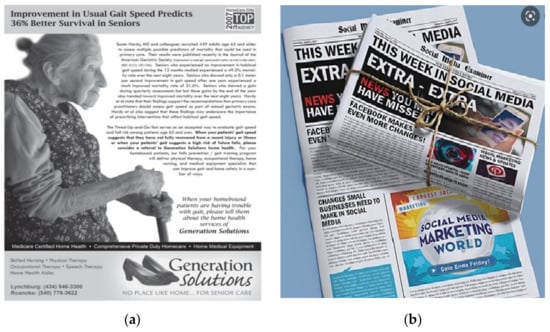
Figure 1.
Example of article-based advertising: (a) Home health-related advertisements [13]; (b) Newspaper advertisement-related data provided by “India Mart” [14].
The following describes some of the problems of such article-based advertising and the difference between article-type advertising and press releases:
- (1)
- Problems with advertising articles [15]:
- (1)
- Advertising is a free commercial expression and has value as content. However, illegal advertisements disguised as articles cannot be considered typical expressions.
- (2)
- Whether it is legal or illegal, from the perspective of a company it is necessary to consider whether article-type advertisements will help to promote the company and increase brand awareness. When disguised article-type advertisements are illegally given exposure and later revealed as disguised advertisements, the brand image may be damaged.
- (3)
- Disguised illegal advertising articles not only infringe on the editor’s editorial rights but can also be an obstacle for companies to develop media relations.
- (4)
- For article-type advertisements, the company pays an advertisement fee. It publishes the content after discussing the article’s contents with the person in charge of the advertising or business department, not the press reporter. Therefore, normal media relations with the editorial staff will not be formed. Reporters generally do not send press releases to request reports and are more likely to distrust companies that unwittingly published advertisements.
- (5)
- Journalists are professionals whose mission is to report newsworthy events promptly. If you ask a reporter to write an advertisement article, they will experience psychological stress because they must make an article by pretending it is new news, even if it has no news value or timeliness.
- (2)
- Differences between article-type advertisements and press releases [15]:
- (1)
- It is far more advantageous to distribute press releases than to advertise when there are newsworthy events or news.
- (2)
- In developed countries such as the US and the UK, it is legally mandatory for listed companies to distribute press releases through online services to bridge the information gap between institutional investors and the public.
- (3)
- If you write a press release and distribute it to reporters, the media will report it without paying advertising fees. Distribution of press releases is the most powerful means of publicity without cost.
- (4)
- For press releases, the author is a company, institution, or organization, and the author’s affiliation, name, and contact information are attached at the bottom of the press release. A press release is entirely different from an article-type advertisement packaged as an article by paying an advertisement fee. It discloses that it is the author by revealing the source, author, and contact information.
2.2. Medical Advertisement [1]
The fact that a “medical advertisement” is an advertisement is stipulated that there is a limit to having an objective appeal to readers, and there is also a limit to receiving legal sanctions for content description. Therefore, in recent years, there has been an increasing tendency to promote hospitals and clinics through “medical articles” rather than “medical advertisements”.
Since “medical articles” have a social responsibility to provide “medical information” to readers, the objectivity and scientific nature of the article content must be guaranteed, and excessive exaggeration differing from the facts must be excluded. In other words, “advertisement” is an economic activity that receives an appropriate advertising fee from media organizations because it specifies that it is a commercial means to promote product sales, whereas “articles” are the public duty of the media organization to deliver accurate information to readers. However, if the intention of a “medical article” itself is “promotion of a specific hospital and clinic” rather than “delivery of medical information” it should be called an “advertisement article” rather than a “medical article”, as it can be said that it is a joint product of a medical institution.
In fact, “advertisement articles” by media organizations are not necessarily limited to “medical articles”. Representative examples include articles about universities and institutes related to the education market and preparing for entrance exams. Nevertheless, the reason that ”advertisement articles” related to medical care should be treated distinctly from other fields is that the knowledge and information delivered through the articles can have a profound effect on the public’s health care as well as preferences for specific procedures, specific medical personnel, and specific medical institutions. Because it affects nutrition, if “medical articles” containing unverified and distorted knowledge and information are reported, it can cause financial damage in addition to impacting health and life for the public, and shake the foundation of the medical system, including the medical delivery system.
The following (Figure 2) is an example of an article-style full-page advertisement in Korea, briefly showing an advertisement for an oriental medicine hospital in a famous Korean magazine and a full-page ad for real estate in a prominent Korean newspaper. These advertisements can often be seen in offline daily newspapers and magazines. Still, since these articles are often published together in online media, it can be thought that newsworthy advertisements are expanding indiscriminately both online and offline.
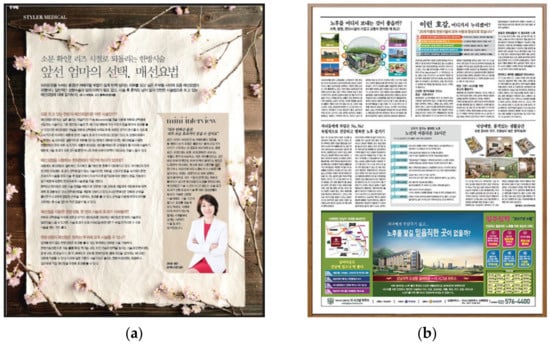
Figure 2.
Cases of article-style full-page advertisements in Korea: (a) Full-page advertisement for articles related to oriental medicine hospitals in a famous magazine in Korea [16]; (b) Full-page advertisement for real-estate-related articles in famous Korean daily newspapers [17].
3. Knowledge-Based Management Systems (KBMS) and Deep Learning
3.1. Knowledge-Based Management Systems (KBMS) [18]
In modern society, which is a knowledge-based society, the importance of knowledge is increasing day by day. Amid these changes, many companies have introduced knowledge management systems to efficiently manage and utilize knowledge resources within their organizations to strengthen their core competencies and secure competitive advantages. However, in the initial knowledge management system, there are systemic problems, such as not correctly providing appropriate knowledge to corporate members, and organizational issues, such as corporate members not actively participating in the system.
To solve this problem, the knowledge management system has been continuously developed thanks to the development of web technology and information technology. The first-generation knowledge management system is an independent system that focuses on accumulating knowledge. The second-generation knowledge management system is an integrated system constructed and distributed according to this purpose. In addition, the third-generation knowledge management system is a system that increases the utilization of knowledge by linking the dispersed understanding with the work process. Finally, the fourth-generation knowledge management system introduces the technology used in the Web 2.0 environment to allow users to voluntarily engage in knowledge-creation activities. It is a system that supports the fourth generation of the knowledge management system. It creates more accurate and creative knowledge by integrating the knowledge or experiences of various people by embracing the concept of collective intelligence as a means of creating knowledge through collaboration. However, even the fourth-generation knowledge management system did not completely solve the organizational problem. In other words, since there is still a lack of factors to encourage the participation of company members, only a small number of members participate in the knowledge management system to produce and share knowledge. There are limits; additionally, there is a structural problem that certain members must directly search for appropriate knowledge [19].
In modern society, companies must constantly strengthen their core competencies to respond to the ever-changing demands of the market and customers and to gain a sustainable competitive advantage. To this end, it is necessary to produce differentiated products from competitors by utilizing knowledge that is recognized as a fundamental success factor and a source of excellent competitiveness for a company. As a result, it became essential to share the knowledge possessed by members of the organization and manage it so that it can be utilized in various forms, that is, knowledge management. Specifically, knowledge management refers to improving organizational performance and productivity by bringing knowledge, including databases, documents, policies, procedures, and the experiences of employees, which were not previously included in systematic management, to the leadership. For this purpose, it means a series of activities used to systematically find and collect know-how and information assets relevant to an organization’s actions and organize, share, and evaluate them. This knowledge management has developed into a knowledge management system with the development of information and communication technology, and the knowledge management system is being actively applied from the perspective of knowledge in corporate management [20].
A knowledge management system is an information technology system that supports an integrated knowledge management process to maximize the value of knowledge resources within an organization. A practical knowledge management system organically combines internal knowledge and external knowledge and its effectiveness is maximized when the knowledge required for the environment outside the organization and the knowledge inside the organization are matched. Integration within the organization includes not only individual expertise and organizational knowledge but also organic integration with existing information systems. This includes integration with suppliers, strategic partners, suppliers, or customers [21].
However, despite the advantages of such a knowledge management system, there are several problems regarding operation and design. For example, the link between knowledge activity and performance management is insufficient, so it may be biased toward formal system operation for evaluation. Knowledge reproduction and new knowledge creation activities may be weak due to a flawed compensation system within the organization. In addition, many companies are only performing warehouse-style knowledge management focused on accumulating knowledge because knowledge production capabilities are weak due to a lack of support for knowledge activities within the organization, and the connection between work processes and learning is not established correctly. Lastly, the operation of a knowledge management system centered on tacit knowledge, which is challenging to express externally because it is composed of individual subjective experiences, can put an excessive burden on the members of the organization [18].
Through the knowledge work process for decision-making, the resultant structured knowledge is continuously accumulated and related to each other to form a knowledge base. In the knowledge work process, storage, search, navigation, modification, sharing, copying, deletion, merging, and separation of knowledge stored in the knowledge base must be performed. For this purpose, a knowledge base management system is required.
In addition, the knowledge base management system provides an interface for the client that provides the knowledge service as shown in Figure 3. The essential functions of the knowledge base management system are as follows [5]:
- (1)
- Function to store knowledge instance according to meta-knowledge;
- (2)
- Change function to enable addition, deletion of knowledge, and change of structure and attributes;
- (3)
- Knowledge search function to search sub-knowledge at the required level of meta-knowledge;
- (4)
- For meta-knowledge management, the knowledge base management system has a meta-knowledge definition function that can define, delete, and change meta-knowledge;
- (5)
- Version control function of knowledge used to deal with the same expertise in terms of hierarchy and content;
- (6)
- Function to extract meta-knowledge by finding similarities in multiple accumulated knowledge;
- (7)
- Ability to force existing knowledge to follow the rules of new meta-knowledge
- (8)
- Meta-knowledge management functions, such as a function to check for violations of meta-knowledge definitions.
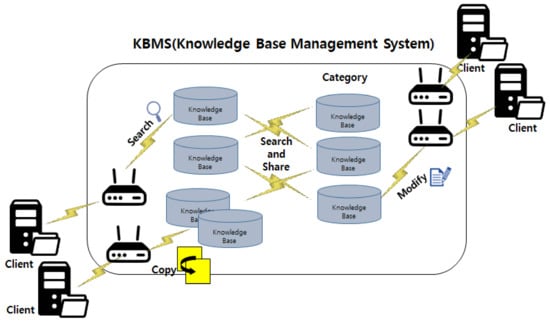
Figure 3.
Overview of Knowledge Base Management System (KBMS) [5].
3.2. Deep Learning
Deep Learning is a technology used to cluster or classify objects or data. Computers, for example, cannot tell the difference between a dog and a cat using only pictures; however, people can tell them apart very quickly. For this purpose, a method called “Machine Learning” was devised. This is a technology that inputs a lot of data into a computer and classifies similar ones. When a picture like the stored dog picture is input, the computer classifies it as a dog picture.
Many machine learning algorithms have already appeared on how to classify data. Representative examples include “decision tree”, “bayesian network”, “support vector machine (SVM)”, and “artificial neural network”. Among these, Deep Learning is the descendant of artificial neural networks. Deep Learning is a machine learning method proposed to overcome the limitations of artificial neural networks. The beginning of Deep Learning is rooted in the history of artificial neural networks. In 1943, Warren McCulloch, an associate professor of psychiatry at the University of Illinois, USA, and Jerry Letbin and Walter Pitts, who were medical students at the time, published a paper titled “The Logical Calculation of Concepts Inherent in Neural Activity”. In this paper, they modeled the neural network as a network in which “binary switching” elements are intricately connected. This is the first paper to conceptualize an artificial neural network. Deep Learning was first proposed in the 1980s, 40 years after the birth of artificial neural networks. It is from the appearance of a book called <PDP>, which summarizes the research on neural networks by psychologists and computer-related scholars at the University of California. It was in 2004 that Deep Learning fired a signal of revival. When Professor Jeffrey Hinton proposed a new Deep Learning-based learning algorithm called RBM, it began to attract attention. An algorithm called dropout appeared soon after, which made it possible to solve chronic overfitting [21].
It is an advanced form of machine learning that learns and predicts itself without inputting data to be understood by humans. These models evolved from artificial neural networks citing human neural networks. Deep Learning utilizes one of the machine learning techniques, Feature Learning. Deep Learning is a Deep Neural Network (DNN) developed from artificial neural networks. It is called hierarchical feature learning because it is a model in which several neurons transmit signals to successive neurons [22].
The core of Deep Learning is prediction through classification. By discovering patterns in numerous sets of data, the computer divides the data just as humans distinguish objects. There are two ways to classify this, these are “supervised learning” and “unsupervised learning”. Existing machine learning algorithms are primarily based on supervised learning. Supervised learning is a method of teaching information to a computer first. For example, give a picture and say, “this picture is a cat”. Based on the pre-learned results, the computer classifies the cat pictures. Unsupervised learning does not have this learning process. Without the learning process of “this picture is a cat”, the computer learns “this picture is a cat” by itself. It is an advanced technology compared to supervised learning and requires high computing power. Google has developed a Deep Learning technology that identifies cat videos among videos registered on YouTube through an unsupervised learning method. Google is also introducing Deep Learning technology to create artificial intelligence systems for robots, including voice recognition and translation. Facebook, a leading social media company, applies Deep Learning to news feeds and image recognition [21].
Let us look at an example related to Deep Learning as a method of judging animals, as shown in Figure 4. In the case of machine learning, a person extracts the characteristics of a dog and a machine learns the extracted characteristics to determine whether it is a cat or a dog. On the other hand, in Deep Learning, all processes of feature extraction and education are performed by machines [22].
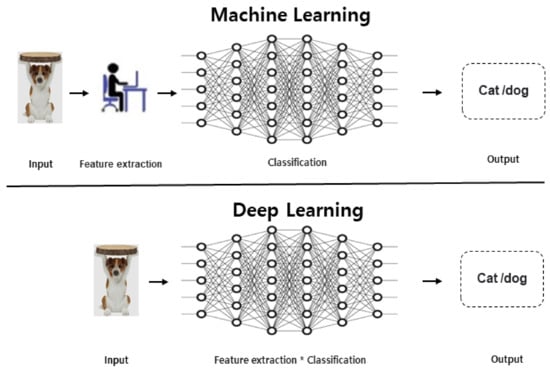
Figure 4.
Difference between machine learning and Deep Learning [22].
Deep Learning is one of the latest artificial intelligence fields in machine learning classification. A model that is Deeper and more complex than machine learning and can learn from a dataset including input and output values [23]. As of 2020, it stands out in text recognition, speech recognition, image classification, and recommendation systems. Both research on performance improvement of Deep Learning models and applied research for real-life applications are being actively conducted. In traditional machine learning, because the model structure is simple input values must be manually simplified through pre-processing to obtain relevant results. Which is superior to machine learning in terms of consistency and performance [24].
4. Refined Information Service Design Using Knowledge Base and Deep Learning
If you look at internet articles provided by portal sites such as Google and Naver recently, you can see a lot of article advertisements explaining the functions of specific companies or products rather than giving public expertise or reporting. Due to such reckless advertising, there are many difficulties when an individual wants to find accurate information and articles. Negative experiences with these advertisements lead to advertisement avoidance, and if media users avoid advertisements, the media’s existence is threatened.
Therefore, in this system, a knowledge-based system and a natural language processing (NLP) machine learning technique can be used to classify these article advertisements. First, we try to classify specific words with advertisement characteristics in articles through the knowledge-based system and classify them as article advertisements.
First, in the knowledge-based management system, we use “if… then…”; this is a procedure to check whether a specific word is included in an article in a format. It filters out certain words and is classified in a tree format, and the result can be reliably trusted. However, there may be articles that secretly advertise without using specific words, and such processing can be classified using Deep Learning techniques, including natural language processing.
The following (Figure 5) shows the overall configuration for extracting advertisement articles. First, newspapers and advertising agencies post articles and advertisements in various forms. The reality is that among this content, there are many article advertisements hidden in a clever way that users do not understand well. The contents are provided by the user’s refined articles by this system. This method is performed by using Deep Learning, including a knowledge-based management system (KBMS) and a natural language processor. These elegant contents are updated and serviced in a differentiated database, and these contents are continuously evaluated. The estimated contents are also learned and modified by Deep Learning, a system that provides more accurate information to users.
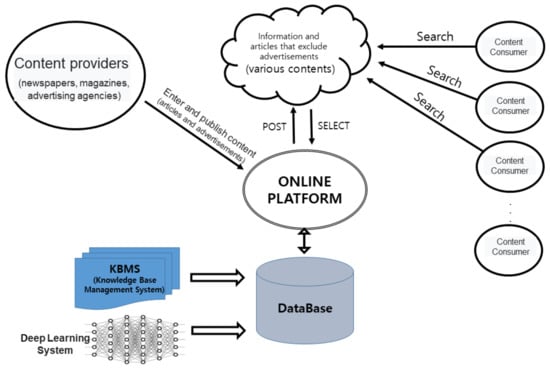
Figure 5.
The overall composition of advertisement article extraction.
The following (Figure 6) shows the configuration of specific word extraction and purification steps in the first stage of the knowledge-based management system, refining by keywords such as full-page advertisement, full-page PR, PR special, planned advertisement, planned special, and product information. In the second stage, refinement is performed by giving more detailed keywords such as company name, product name, product description, function description, and medical column. With the information refined in the second step, the third round of refining is done by using the Deep Learning method.
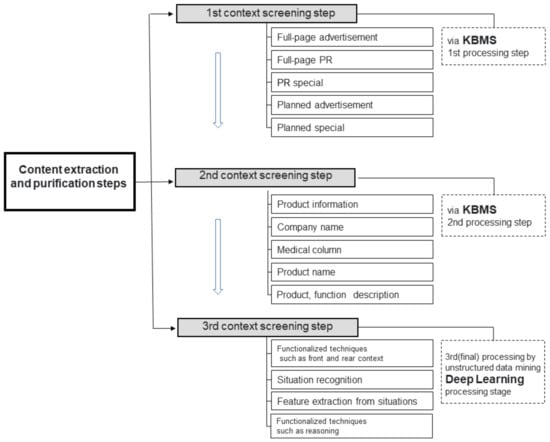
Figure 6.
Structure diagram of specific advertising word extraction and purification steps.
The processing method of Deep Learning involves creating more natural and high-quality content with context and situation information added. This Deep Learning method recognizes advertisement-related keywords and contexts before and after to improve recognition accuracy. As these steps increase accuracy, this method can obtain customized online articles after sufficient learning about ad-inducing keywords.
4.1. Knowledge-Based System for Specific Word Extraction
The first step to providing refined articles is to make a knowledge-based management system. This is the step where we extract and refine exact primary keywords that have the same meaning as advertising words, and the reliability can be guaranteed.
4.2. Natural Language Processing Deep Learning Techniques
Natural language processing is one of the main fields of artificial intelligence that studies and implements human language phenomena to be described using machines, such as computers. Natural language processing is closely related to linguistics, which studies language itself, and language cognitive science, which explores the internal mechanisms of language phenomena, since the subject of study is language. It is a representative field that uses many mathematical and statistical tools for implementation, especially machine learning tools. Various applications such as information retrieval, QA system, automatic document classification, newspaper article clustering, and interactive agent are being developed. Morphological analysis in natural language processing means analyzing a specific target word into “morpheme”, the smallest unit of meaning. (A morpheme can be a word itself but is generally a smaller unit than a word). It is often used in information search engines to extract Korean index words [25].
Figure 7 shows the overall configuration of a Deep Learning and knowledge-based customized information service and essential information purification by keywords and “Deep”. This is a structure that provides high-quality content to users after advanced information extraction by “learning”. This information is stored in the “database” and continuously modified, and the final knowledge information is displayed by using the “knowledge inference engine” and “knowledge search engine”. The overall refining step is performed primarily by KBMS, secondarily by Deep Learning techniques including natural language processing, and providing highly refined content is performed in the third step, which is the content shown to users. This is the step where we provide the learned and corrected information gathered by Deep Learning through continuous search and inference steps and in the last four steps, this is performed in the “refined knowledge content viewing” step in Section 4.3, which is a structure in which the user continuously modifies and updates the information provided by the knowledge search and recommendation engine, and this is also done by Deep Learning.
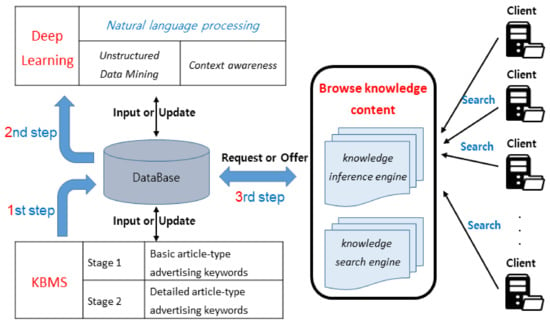
Figure 7.
The overall configuration of customized information service based on Deep Learning and knowledge.
4.3. Refined Knowledge Content Viewing
The final stage of content is to read the refined knowledge content, which consists of a circulation structure in which knowledge content is read and evaluated through a knowledge recommendation engine or knowledge search engine. When correction is necessary, the knowledge content is revised. In other words, essential keywords of the advertisement related to the article type entered the knowledge-based management system are inputted into the interest area tag list. After that, to view advanced knowledge content as shown in Figure 8, knowledge content is read and evaluated through a knowledge recommendation engine or knowledge search engine. If correction is necessary, it is composed of a circulation structure. In other words, more natural and accurate information is created through context flow and situation recognition by Deep Learning. If necessary, it is possible to secure more refined content by performing the “knowledge evaluation mode” to perform Deep understanding once again through the revision stage of re-reading.
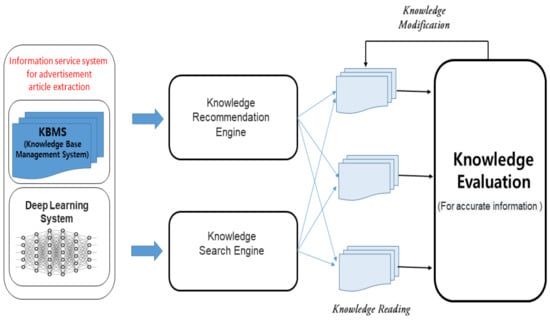
Figure 8.
3 Refined knowledge content extraction Process.
5. Discussion
Although the issue of this article-based advertising is a global problem, this study mainly addresses the situation in Korea. In Korea, when advertisements that could become newsworthy occur indiscriminately, the article and part of the advertisement are unclear, so readers need to clearly distinguish them. The purpose of this is to allow readers to categorize because advertisements are meaningless for subscribers who want to get only pure articles.
The contents obtained through this study are the same as the conclusion, but the remaining tasks and research needs are considered as follows:
- In future studies, it is necessary to implement the contents designed in this study;
- It is necessary to determine what the scope of the article-based advertisement is;
- It is necessary to compare and analyze the scope of article advertisements regulated in each country.
6. Conclusions
When you look at internet articles provided by many portal sites such as Google and Naver, you can see many article advertisements that explain the functions of specific companies or products rather than public expertise or reports. Due to this, there are many difficulties when an individual wants to find the exact information and articles. Such adverse experiences with advertisements lead to advertisement avoidance, and if media users avoid advertisements, the media’s existence is threatened.
To solve this problem, this system was researched to acquire desired information, excluding advertisement articles when reading online. The basic function of this system is to store and search advertisement phrases or general keywords related to a specific company and product promotions in the database system of the knowledge-based management service in the first step to obtain more accurate information. This method involves accessing a database in which advertisement-related keywords are stored by KBMS, comparing it with the content to be searched, and retrieving the desired information after performing extraction and purification processes. When you want high-quality content with more accuracy than the content that is refined and provided in KBMS, you have a three-step extraction and purification process that applies Deep Learning technology. These methods are “situation recognition” and “natural language processing” steps that are more natural and increase recognition accuracy by recognizing the contexts of ad-related keywords and contexts before and after. Finally, it may be used as a method to obtain customized online articles.
This system compares advertisement phrases or general keywords related to specific companies and product promotions with the content to be searched for in the database system of the knowledge-based management service. It retrieves the desired information after extracting and refining unnecessary definitions. In addition, as a method for obtaining more accurate information, it is designed to have an extraction and purification process to get the desired information through the final step, where Deep Learning technology is applied. That is, the final stage of these contents is to go through the advanced knowledge content reading, which consists of a circular structure in which the knowledge content is read and evaluated by a knowledge recommendation engine or a knowledge search engine, and when correction is necessary the knowledge content is revised. The basic and essential keywords of the advertisement related to the article type which enters the knowledge-based management system are inputted into the field of the interest tag list. After that, more natural and accurate information is created through context flow and situation recognition by Deep Learning. If necessary, it is possible to secure more refined content by performing the “knowledge evaluation mode” to perform Deep understanding once again through the revision stage of re-reading.
The final purpose of this study conducted in this way is that it can be utilized in online platforms and search sites. As a result, additional optional functions are given to differentiated users so that the accuracy of information excluding advertising articles is improved and quality articles can be obtained.
Author Contributions
Conceptualization, Y.K.; Data curation, Y.K.; Formal analysis, Y.K.; Funding acquisition, Y.-C.B.; Investigation, Y.-C.B.; Methodology, Y.K.; Writing—original draft, Y.K.; Writing—review & editing, Y.-C.B. and S.-J.L. All authors have read and agreed to the published version of the manuscript.
Funding
This research was supported by the 2022 scientific promotion program funded by Jeju National University.
Institutional Review Board Statement
Not applicable.
Informed Consent Statement
Not applicable.
Conflicts of Interest
The authors declare no conflict of interest.
References
- Kim, B. What’s the problem with “Advertising Medical Articles”? Medical Policy.
- Cho, C.; Cheon, H.J. Why do people avoid advertising on the internet? J. Advert. 2004, 33, 89–97. [Google Scholar] [CrossRef]
- Choi, H.-J.; Lee, Y.-J.; Jeon, J.-W. Factors Affecting Hostility to and Avoidance of Ads Impersonating Online Articles. Advert. Res. Winter 2021, Volume 131. Korean Advertising Promotion Academy. Available online: http://www.kadpr.or.kr (accessed on 20 September 2022).
- Lee, S.-G. The concept and current status of the knowledge-based service industry, and how to foster it. Korean Econ. Res. 2008, 22, 205–239. [Google Scholar]
- Lee, D.-W.; Kim, J.-J.; Jeong, B.-C.; Lee, T.-S.; Jo, D.-H. An overview and development direction of future knowledge services. J. Inf. Sci. 2009, 7, 18–24. [Google Scholar]
- Kang, M. The actual situation of article advertisement and improvement plan. Korean Advert. Public Relat. J. 2003, 5, 1–41. [Google Scholar]
- Cameron, G.T. Does publicity outperform advertising? An experimental test of the third-party endorsement. J. Public Relat. Res. 1994, 6, 185–207. [Google Scholar] [CrossRef]
- Kim, B.-C.; Kim, J.-S.; Lee, H.-S. A Study on the Effective Operation of the Self-Review System for Media Reports and Advertisements (Research Report 2012-02); Korea Press Foundation: Seoul, Korea, 2012. [Google Scholar]
- Ahn, S.-T. A study of article confusion in Internet newspaper text advertisements. Korea Broadcast. Gaz. 2013, 27, 124–161. [Google Scholar]
- Kim, B. Content analysis on the usage behavior of ‘hybrid’ advertisements in print media: Focusing on article-type advertisements published in the four major domestic daily newspapers. Advert. Stud. 1998, 9, 123–139. [Google Scholar]
- Kim, B. A study on the form and editing method of article-type advertisements in newspapers: Focusing on content analysis. Advert. Stud. 2007, 18, 259–288. [Google Scholar]
- Jeon, J.-W.; Choi, H.-J.; Kwon, K.-H. Internet Newspaper Advertisement Landing Page Impersonation Landing Advertisement Status and Consumer Awareness Survey; Internet Newspaper Commission: London, UK, 2022. [Google Scholar]
- Home Health-Related Advertisement. Available online: https://brazzellmarketing.com/Home-Health-Ads.html (accessed on 20 September 2022).
- News Paper Magazine Advertisement Service. Available online: https://www.indiamart.com/proddetail/news-paper-magazine-advertisement-service-22202855997.html (accessed on 20 September 2022).
- Newswire. The Difference between Advertising Articles and Press Releases. Available online: https://www.newswire.co.kr/?ed=359 (accessed on 20 September 2022).
- Editorial Style Layout Advertisement (Article Type Advertisement). Available online: https://blog.naver.com/alswjddk4830/221505827338 (accessed on 5 April 2019).
- Hanmo Communication, Real Estate Advertisement—Article-Style Full-Page Advertisement. Available online: https://blog.naver.com/hmc031/22097530588 (accessed on 20 September 2022).
- Ahn, G.; Kwon, M.; Kang, C.; Hu, S. Design of Fourth Generation Knowledge Management System based on Social Network Service. J. KIISE 2016, 43, 579–589. [Google Scholar] [CrossRef]
- Cho, B. Design of Knowledge Management System based on SNS. J. Inst. Internet Broadcast. Commun. 2014, 14, 181–186. (In Korean) [Google Scholar] [CrossRef]
- Seo, D.; Baek, J.; Cho, D. A Multi-Agent Scheme Considering User’s Mobility RFID based on Knowledge Management System. J. KISS Inf. Netw. 2010, 37, 99–108. (In Korean) [Google Scholar]
- [Naver Knowledge Encyclopedia] Deep Learning—Thinking Computer through Learning (IT in Terms, Wonseok Oh). 2020. Available online: https://terms.naver.com/entry.nhn?docId=3578519&cid=59088&categoryId=59096 (accessed on 14 August 2014).
- Kang, S. Artificial Intelligence/Machine Learning/Deep Learning Concept. 2020. Available online: http://blog.naver.com/jevida/221843366216 (accessed on 8 March 2020).
- LeCun, Y.; Bengio, Y.; Hinton, G. Deep Learning. Nature 2015, 521, 436–444. [Google Scholar] [CrossRef] [PubMed]
- Lee, K.B.; Shin, H.-S.; Kim, S.H.; Ha, D.M.; Choi, I. A Study on Automatic Classification of Characterized Ground Regions on Slopes by a Deep Learning based Image Segmentation. Tunn. Undergr. Space 2019, 29, 508–522. [Google Scholar]
- Natural Language Processing, “Wikipedia”. Available online: https://en.wikipedia.org/wiki/Natural_language_processing (accessed on 24 September 2022).
Publisher’s Note: MDPI stays neutral with regard to jurisdictional claims in published maps and institutional affiliations. |
© 2022 by the authors. Licensee MDPI, Basel, Switzerland. This article is an open access article distributed under the terms and conditions of the Creative Commons Attribution (CC BY) license (https://creativecommons.org/licenses/by/4.0/).